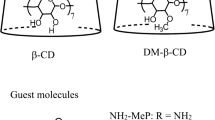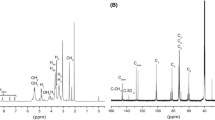Abstract
We report that 1:1 and 1:2 complexes are formed for 2-hydroxy-9-fluorenone with β-cyclodextrin (β-CD) and that there is an unusual red shift in emission at higher concentrations of β-CD. Between different stoichiometries of the complexes the titrimetric curves for the neutral–anionic equilibria for the guests differ drastically and so do the excited state pK values. The formation of an 1:1 inclusion complex with 2-hydroxy-9-fluorenone (2HFN) as the guest in β-CD with the binding constant (K) of 606.65 L·mol−1 was determined. The ground and excited state pK a values for the neutral–mono-anion equilibrium are not affected by β-CD. Hence the hydroxyl group is considered exposed in the aqueous environment. Two different types of inclusion complexes of 2HFN were observed in β-CD. The 1:2 complex of 2HFN shows a red shift from the 1:1 complex and is less fluorescent that the 1:1 complex. The red shift reveals that the 1:2 complex is more stabilized than the 1:1 complex. The excited state pK a values in both complexes with β-CD are higher that those in aqueous solution. This shows that the complexation makes the molecule less acidic in the S1 state. The β-CD molecule is perceived as not able to encapsulate the 2HFN molecule fully, but the larger rim of the β-CD comes closer to the C=O group. The other half of the 2HFN molecule is encapsulated by the second β-CD molecule and thus there is formation of the 1:2 inclusion complex at higher concentrations of β-CD.










Similar content being viewed by others
References
Wenz, G., Han, B., Moller, A.: Cyclodextrin rotaxanes and polyrotaxanes. Chem. Rev. 106, 782–817 (2006)
Terdale, S.S., Dagade, D.H., Patil, K.J.: Thermodynamic studies of drug–cyclodextrin interactions in water at 298.15 K: Promazine hydrochloride/chlorpromazine hydrochloride–CD–H2O systems. J. Phys. Chem. B 111, 13645–13652 (2007)
Song, L.X., Bai, L., Xu, X.M., He, J., Pan, S.Z.: Inclusion complexation, encapsulation interaction and inclusion number in cyclodextrin chemistry. Coord. Chem. Rev. 253, 1276–1284 (2009)
Frixa, C., Scobie, M., Black, S.J., Thompson, A.S., Threadgill, M.D.: Formation of a remarkably robust 2:1 complex between beta-cyclodextrin and a phenyl-substituted icosahedral carborane. Chem. Commun. 23, 2876–2877 (2002)
Krause, R.W.M., Mamba, B.B., Dlamini, L.N., Durbach, S.H.: Fe–Ni nanoparticles supported on carbon nanotube–co-cyclodextrin polyurethanes for the removal of trichloroethylene in water. J. Nanopart. Res. 12, 449–456 (2010)
Rekharsky, M.V., Inoue, Y.: Complexation thermodynamics of cyclodextrins. Chem. Rev. 98, 1875–1917 (1998)
Connors, K.A.: Population characteristics of cyclodextrin complex stabilities in aqueous solution. J. Pharm. Sci. 84, 843–848 (1995)
Connors, K.A.: Measurement of cyclodextrin complex stability constants. In: Szejtli, J., Osa, T. (eds.) Cyclodextrins. (in: Atwood, J.L., Davies, J.E., MacNicol, D.D., Vögtle, F., Lehn, J.-M. (eds.) Comprehensive Supramolecular Chemistry, Chap. 2.) Elsevier, New York (1996)
Enoch, I.V.M.V., Swaminathan, M.: Spectral and photoprototropic characteristics of 4-aminobiphenyl in β-cyclodextrin. Collect. Czech. Chem. Commun. 69, 748–758 (2004)
Enoch, I.V.M.V., Swaminathan, M.: Dual fluorescence and photoprototropic characteristics of 2-aminodiphenylsulphone-β-cyclodextrin inclusion complex. J. Incl. Phenom. Macrocycl. Chem. 53, 149–154 (2005)
Enoch, I.V.M.V., Swaminathan, M.: Fluorimetric study on molecular recognition of β-cyclodextrin with 2-amino-9-fluorenone. J. Fluoresc. 16, 501–510 (2006)
Enoch, I.V.M.V., Swaminathan, M.: Flourimetric and prototropic studies on the inclusion complexation of 2-amino and 4-aminodiphenyl ethers with β-cyclodextrin: Unusual behavior of 4-aminodiphenyl ether. J. Lumin. 127, 713–720 (2007)
Panja, S., Chakravorti, S.: Dynamics of twisted intramolecular charge transfer process of 4-N,N-dimethylaminocinnamic acid in α-cyclodextrin environment. Chem. Phys. Lett. 336, 57 (2001)
Bezrukova, A., Lubomska, M., Rogalski, M.: Nanoparticle mixtures of anthracene and β-cyclodextrin testing by optical spectroscopy. Rev. Adv. Mater. Sci. 20, 70–76 (2009)
Chattopadhyay, N.: Effect of cyclodextrin complexation on excited state proton transfer reactions. J. Photochem. Photobiol. A 58, 31–36 (1991)
Yarozu, T., Hoshino, M., Shizuka, H.: Photoexcited inclusion complexes of beta-naphthol with alpha-, beta-, and gamma-cyclodextrins in aqueous solutions. J. Phys. Chem. 86, 4422–4426 (1982)
Bortolus, P., Marconi, G., Monti, S., Mayer, B., Kohler, G., Grabner, G.: Interaction of 4-hydroxybiphenyl with cyclodextrins: Effect of complex structure on spectroscopic and photophysical properties. Chem. Eur. J. 9, 1578–1591 (2000)
Author information
Authors and Affiliations
Corresponding author
Rights and permissions
About this article
Cite this article
Enoch, I.V.M.V., Yousuf, S. β-Cyclodextrin Inclusion Complexes of 2-Hydroxyfluorene and 2-Hydroxy-9-fluorenone: Differences in Stoichiometry and Excited State Prototropic Equilibrium. J Solution Chem 42, 470–484 (2013). https://doi.org/10.1007/s10953-013-9965-1
Received:
Accepted:
Published:
Issue Date:
DOI: https://doi.org/10.1007/s10953-013-9965-1




